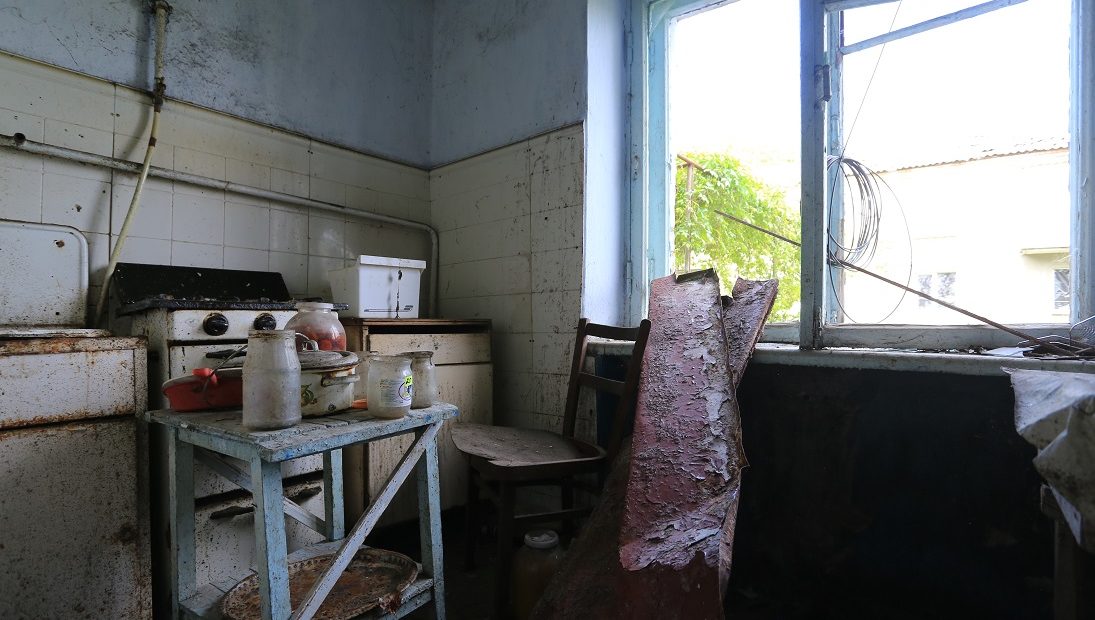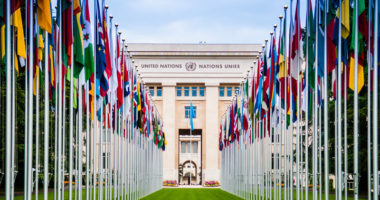They say a picture is worth a thousand words, but images taken during modern conflicts instill a different sense of interpretation. Humanitarian communications, specifically photography, take on a new meaning when each photo exhibits the work of humanitarian action.
In this post, ICRC Law and Policy Digital Marketing Officer Stephanie Xu reflects on her time in the field after a three-month support mission and ponders on the aspects of neutrality from a completely different angle.
The warm spring breeze follows me as I step through the door of the building. I hear the soft crunch of shattered glass beneath my feet, milliseconds before I visually take in the damage of the first apartment we visit. “Damage” to the living room is an understatement – doors lie horizontally beneath their frame as if waiting to be mounted again; couch fabric shredded into so many pieces they form a completely new design; thick layers of debris piling across surfaces to create a protective coat. What used to be windows are simply empty frames in the wall, a direct view into the growing weeds of the vacant building across the street.
A jar of untouched pickled plums amidst an unrecognizable kitchen lingers in my memory as we drive back to the ICRC sub-delegation office. How cruel destruction can be to reduce the presence of human life into a single item.
Over the next few weeks, I would accompany several site visits and photograph a variety of ICRC activities in affected areas. From building and water supply donations to providing mental health activity books for schools to delivering messages from prisoners of war (POWs), these activities illustrate the constant fluctuation of needs, support, and international humanitarian law (IHL) compliance in an armed conflict. And like many of my colleagues around the world, we photograph such elements not only to demonstrate our humanitarian assistance but also to showcase the humanity in our work that has guided us for over 160 years.
Yet, I return, time and time again to a recurring question, often present when I put down my camera after a long day of capturing these moments – how can we photograph neutrality, a fundamental principle at the core of carrying out our mandate? How do we capture this fundamental principle in a single frame, when our operations take place in a myriad of contexts? Is it even possible to photograph neutrality, a concept completely intangible compared to the solidity of an object such as the Geneva Conventions?
Answering and attempting to answer this question is both difficult and simple. Difficult in the way that the 20,000 ICRC staff worldwide can conjure up 20,000 different ideas based on their individual interpretations and experiences. Yet, simple given that there are certain depictions we will never see given the incorrect representations we’ve witnessed in the history of humanitarian communications. Neutrality is not poverty porn, narrowing our beneficiaries down to a single image, used only for charity purposes. Neutrality is not the Western gaze, objectifying subjects to a certain ideal removed from the reality of the situation. Neutrality is not selective imagery, choosing to highlight one community over another to gain greater views or engagement.
Instead, neutrality are the photos that showcase a plane full of POWs ready to be returned to their homes. Neutrality are the portraits of those who have endured more than 12 years of the Syrian conflict and continue to share their personal stories. Neutrality are the images of families being reunited after 10-15-20 years of separation, running into each other’s arms, and meeting new relatives. Neutrality is when the beneficiary I meet feels comfortable enough for me to place my camera in front of them.
In any situation of armed conflict, there is a wide range of constraints on humanitarian access that prevent us from documenting needs. Similar to many other organizations in this sector, we are equally aware of the boundaries we must maintain to ensure that those affected are protected and that we only use material with the subject’s consent.
But ICRC’s ability to photograph people affected by conflict for over 160 years is no coincidence. The thousands and thousands of photos in our archives demonstrate our access, acceptance, and agency. Our neutrality has granted us the capacity to document decades of conflict and capture suffering as well as acts of humanity on all sides, visceral reminders of the importance of humanitarian protection and assistance.
When I think back to that early spring day and how I would describe photographing neutrality, I still cannot give a concrete answer. The photographs I captured, along with the powerful work of my colleagues, will continue to stay with me. The images we catalogue in the future may not be any easier to witness, but it gives me a soft reassurance to know that photographing neutrality is only possible because of our neutrality.
See also:
- Hugo Slim, Five types of humanitarian influence, February 7, 2023
- Nicholas Hawton, The art of influencing: how to maximize impact in a complex, interconnected world, December 8, 2022
- Faine Greenwood, Drones and distrust in humanitarian aid, July 22, 2021








Comments